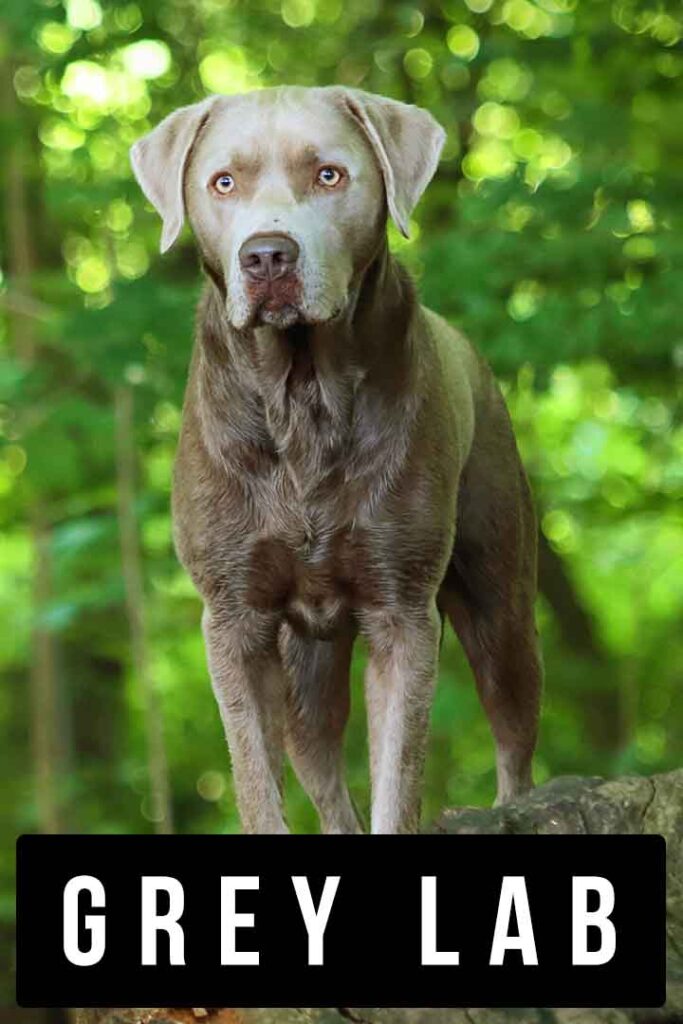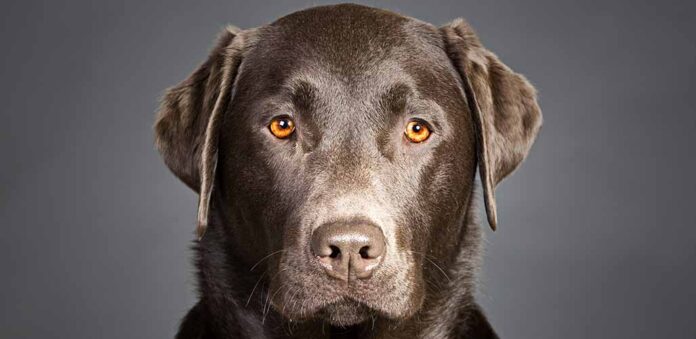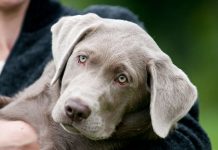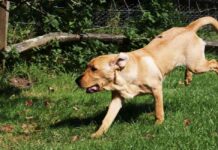The fascinating grey Lab can be officially yellow, chocolate or black in color! A grey Lab puppy might have a brown or black coat and a dilute gene, which makes it look silver or charcoal grey. But an adult grey Labrador could be an older Labrador Retriever who is going grey in their senior years! Today we take a look at the different ways a grey Lab can get their gorgeous grey fur. From color mutations present from birth, to color loss resulting from old age.
- Different types of grey.
- Are grey Labs purebred?
- Silver Lab vs grey Lab
- Charcoal Lab vs grey Lab
- Grey Labradors – aging gracefully
The term grey Lab means different things to different people. Some people interpret it as meaning a silver or charcoal colored Lab, whilst others will call to mind a senior Lab whose coat color is fading with old age.
This litter of silver and charcoal Labrador puppies are grey from birth. Other Labs acquire greyness as they age. Let’s find out more about both!
What is a grey Lab?
Someone referring to a grey Labrador Retriever could mean:
- A black Labrador with color dilution, so their coat looks charcoal grey.
- A chocolate Labrador with color dilution, so their coat looks silver grey.
- Or even a senior Labrador, who is starting to lose the pigmentation in their coat.
Each of these possibilities looks subtly (or not so subtly) different from the other two. And the first two are even considered rather scandalous among some Labrador Retriever purists. Let’s address that controversy head-on first, and then take a more detailed look at each of the types of grey Lab.
Are grey Labs purebred?
The pedigree status of silver and charcoal grey Labs is a divisive topic. The three standard Labrador colors accepted by the American Kennel Club are black, brown and yellow. Charcoal and silver grey coats are modified versions of black and chocolate coats, respectively. They are produced by a gene called the color dilution gene, or simply ‘dilute gene’. The dilute gene suppresses pigment production in hair follicles, so the color appears less saturated. Color dilution inheritance is recessive, which means dogs with only one copy of the gene carry it silently without expressing it. And only puppies who inherit two copies – one from each parent – express it.
Lab breeders are divided as to whether this means the dilute gene has always existed at low frequency in the Labrador population. It would have been expressed very rarely as long as breeders avoided mating two dogs with a known family history of dilute coats together. And affected puppies may simply have been culled at birth. On the other hand, some breeders remain convinced that the dilute gene was not present in Labradors when the breed was founded, and it must have been introduced later by outcrossing with dogs like Weimaraners (and presumably lying about it on the pedigree certificate for the puppies).
It’s unlikely we’ll ever know for sure what happened, but nonetheless grey Labs with silver or charcoal coats can be registered with the AKC today if they can prove qualifying ancestry. So they can be considered purebred, but they won’t be eligible to enter AKC dog shows or compete in their working trials.
Silver Labs
Silver Labs, like the dog below, are born with the genes for a chocolate brown coat, and two copies of the color dilution gene. The result is a soft, shimmering, ethereal warm grey. Their nose leather and paw pads are lighter than usual too, and their eyes are often green. Their temperament is the same as a non-dilute chocolate Lab. Compared to black and yellow Labs, chocolate Labs are consistently described in owner surveys as harder to train, more excitable, more agitated when ignored, and more reactive to loud noises. It’s unlikely that this is directly caused by the color of their coat though. It’s more likely to be because chocolate lines weren’t traditionally used as working dogs, so breeders were less likely to prioritize traits related to working ability.

Health wise, silver Labs’ color dilution means they are also vulnerable to color dilution alopecia (CDA). In dogs with CDA, patches of hair follicles ‘self-destruct’ leaving bald patches in the coat. The exposed skin can also be prone to flaking and itchiness. The hair loss is irreversible, but veterinarians can prescribe medicines to relieve the itchiness and flaking. Unfortunately, chocolate Labradors are also more prone to ear infections, eczema and obesity than black and yellow Labs. They also live for one year less, on average. Since silver coats are based on chocolate, silver Lab puppies also have a shorter average lifespan than other grey Labrador dogs.
Charcoal Lab
Charcoal Labradors have the genetic instructions for a black coat, plus color dilution. The result is the same color known as blue in many other dog breeds. It’s a deep, steely grey coat, with hazel brown eyes – like the dog at the top of this page. Charcoal Labradors have the same temperament as black Labs. All of them are intelligent, active, and friendly with other dogs and people alike. The finer details of their temperament will be influenced by:
- Sex
- Neuter status
- Whether they come from working or show lines
- Early socialization
- Training
- How much physical activity they get
- And even diet.
Charcoal grey Labrador health is generally better than silver Lab health, but they are also vulnerable to color dilution alopecia. Both charcoal and silver Lab puppies are prone to the same common health problems of all Labradors over their lifetime. Namely:
- Hip dysplasia
- Elbow dysplasia
- Allergies
- Gastrointestinal problems
- Ear infections
- Exercise induced collapse
So, whatever color of puppy you choose, it’s important to purchase them from a reputable breeder who only uses health tested sires and dams.
Grey Labradors – aging gracefully
Last but not least, some people asked to call to mind a Grey Lab might think of a senior Lab who is starting to lose the color in their coat. Loss of pigmentation in some of a dog’s coat is a normal part of aging for most dog breeds, including Labs. The change is most obvious in black Labs, because the contrast between pigmented and non-pigmented hairs is starkest. It’s least obvious in yellow Labs, because the contrast can be quite low. And of course, chocolate Labs sit somewhere in between.
When do black Labs start turning grey?
The exact age when a Labrador starts turning grey is very much down to the individual. Just like some people start going grey at an exceptionally young age, whilst others keep their original hair color for an enviably long time. Some dogs also start to get a few greys hairs from as young as 4 years old, whilst others are grey-hair free and youthful at 10. My own black dog has been going grey since he was just two years old! But, the average age for a dog to start collecting grey hairs is between 5 and 7 years old. The first places you’re likely to notice them appearing are around the muzzle, on their eye brows, and between their toes.
Grey lab clothing – keeping your senior dog warm
One of the Labrador’s defining features is their dense double coat, which can keep them warm even whilst swimming in cold water. Their fur usually remains effective at keeping them warm throughout their life. But, senior dogs who are struggling to keep weight on due to loss of appetite, or whose coat is thinning due to, e.g. thyroid disease, might benefit from an extra layer on walks. Especially in wet or windy weather. Our guide to the best Labrador-sized dog coats will help you choose one.
Grey Labrador Retriever summary
Some grey Labradors are born as grey Labrador puppies because they have two copies of the color dilution gene, which makes them silver or charcoal. Other Labradors have greyness thrust upon them as they start to grow old. We’d love to hear from you about what kind of grey Lab you have – tell us about them in the comments section down below!
For more information about some of topics touched on in this article, don’t miss these resources:
- Silver Lab – The Facts About Silver Labrador Retrievers
- Charcoal Lab: The Dilute Black Labrador Retriever
- Caring For An Old Labrador
- Green Labrador – The Most Unusual Puppy Color Of All!
- White Lab Puppy
- Labrador Hackles
- Muscular Labrador
References
- Kaelin & Barsh. Genetics of Pigmentation in Dogs and Cats. Annual Review of Animal Biosciences. 2013.
- Lofgren et al. Management and personality in Labrador Retriever dogs. Applied Animal Behaviour Science. 2014.
- McGreevy et al. Labrador retrievers under primary veterinary care in the UK: demography, mortality and disorders. Canine Medicine & Genetics. 2018.
- Pugh et al. Dogslife: A Cohort Study of Labrador Retriever Health. Society of Veterinary Epidemiology and Preventive Medicine. 2015.
- Van Rooy & Wade. Association between coat colour and the behaviour of Australian Labrador retrievers. Canine Genetics and Epidemiology. 2019.
The Labrador Site Founder
Pippa Mattinson is the best selling author of The Happy Puppy Handbook, the Labrador Handbook, Choosing The Perfect Puppy, and Total Recall.
She is also the founder of the Gundog Trust and the Dogsnet Online Training Program
Pippa's online training courses were launched in 2019 and you can find the latest course dates on the Dogsnet website



















Have a charcoal puppy when he was 10 weeks old noted by vet large puppy dark charcoal with iliac undercoat which shines beautiful in the light n sun. Yes a iliac light purple undercoat. He just turned 5 months 3 weeks old vet visit received last rounds of all vaccines very lean n healthy he now weighs 60 lbs at this puppy months age very large paws Vet n us can’t wait to see his height n weight when he reaches full grown size. We love our new fur baby addition to our family already spoiled